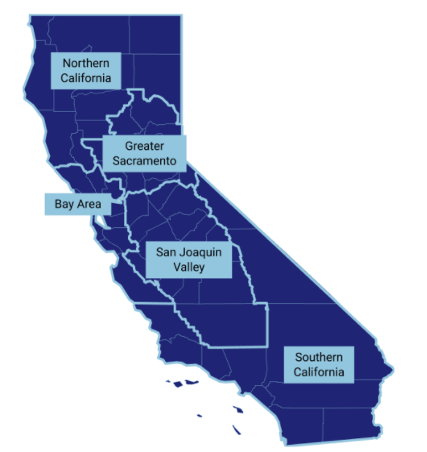Insights
Stay at Home (Again): California’s Regional Stay At Home Order Goes into Effect
Dec 08, 2020On December 3, 2020, the California Department of Public Health issued a Regional Stay At Home Order, which is the most restrictive COVID-19 regulation passed by the state since the original Stay at Home Order issued on March 19, 2020. The Order breaks the state into five regions shown in the map below. When a region’s percentage of available Intensive Care Unit (ICU) beds falls below 15%, the region will be subject to the restrictions of the Order for a period of at least three weeks, and the restrictions continue until available ICU bed capacity is greater than or equal to 15%.
Effective December 6, 2020, both the Southern California Region and San Joaquin Valley Region have fallen below the 15% threshold and are subject to the Order. Contra Costa, Marin, Santa Clara, San Francisco, and Alameda Counties, and the city of Berkeley proactively adopted the restrictions in the Order rather than waiting for ICU capacity to dip below 15%, effective December 6, 2020 (December 7th for Alameda), and continuing until at least January 4, 2021.

Déjà vu All Over Again: What Are the Restrictions under the Regional Stay At Home Order?
In general, the order moves impacted regions of the state back to March closure levels. There are some important differences between the new Order and what the state and many counties required in the early days of the pandemic (e.g. under the Order retailers are still allowed to operate at reduced capacity), but for the most part the Order moves the state all the way back to the closures that began in March.
- Stay At Home - All individuals living in the Region shall stay home, except (1) as necessary to conduct activities associated with the operation, maintenance or usage of critical infrastructure, (2) as required by law, or (3) as specifically permitted in the Order. The activities that are specifically allowed under the order include:
- Being outside and going to outdoor recreational facilities, provided that households do not interact with others.
- Attending worship or political expression events outdoors.
- Schools - Travelling to and from, and attending schools that meet the then-current state and county guidance. This means that schools that are already open will stay open, and new schools can open when permitted by the guidance.
- Gatherings - All gatherings with members of other households is prohibited, subject to certain exceptions.
- Critical Infrastructure - Critical infrastructure sectors may operate and must continue to modify operations pursuant to the applicable sector guidance.
- Retailers - All retailers may operate indoors at no more than 20% capacity and must follow the guidance for retailers. Access must be strictly metered to ensure compliance with the limit on capacity. The sale of food, beverages, and alcohol for in-store consumption is prohibited.
- Hotels and Lodging – No hotel or lodging entity shall accept or honor out of state reservations for non-essential travel, unless the duration of the stay is for the minimum quarantine period and the guest will quarantine at such location for the required period of time.
What is Closed?
- Restaurants – Except for takeout or delivery.
- Non-Critical Infrastructure Offices
- Personal Care Establishments
- Hair Salons and Barbershops
- Gyms and Fitness Centers
- Movie Theaters
- Museums, Zoos, and Aquariums
- Wineries, Breweries and Bars – For onsite consumption.
What Should California Businesses do in Response to the Order?
Businesses in California should determine whether (a) their business qualifies as critical infrastructure; (b) the employees it employs are all essential workers necessary to operate and maintain the business or if such employee(s) should telework; and (c) they need to modify their operations in response to the restrictions under the new Order. If a business is continuing to operate, it should (1) review the state’s Employer Playbook, (2) comply with industry specific guidance, (3) conduct a risk assessment, and develop a COVID-19 Response Plan for each worksite, retail location, office, or other place of business, (4) train employees, (5) implement screening, disinfection, and distancing protocols, (6) require face covering subject to certain exemptions, and (7) post a checklist of all of the above at its facilities.
Should you have specific questions or like additional guidance to ensure compliance with the evolving re-opening requirements, please feel free to contact Tom Lee, Dylan Kornbluth, or the COVID-19 Reopening Team.
Related Practice Areas
-
Employment & Labor
-
Environment
-
Real Estate
-
Regulation, Compliance & Advisory
-
Restaurant Practice
-
Retail & Consumer Products



